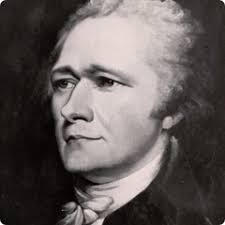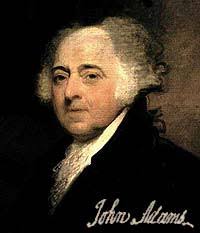The Myth of Religious Freedom in Colonial America
Only three of the original thirteen colonies allowed Catholics to vote. Every colony save Rhode Island prohibited Catholics from holding public office, and no colony allowed Catholic schools except for Pennsylvania. Virginia passed a law ordering the arrest of any priest who entered the state. It was regular practice to celebrate Guy Fawkes Day as their English counterparts did overseas, by burning the Pope in effigy and chanting anti-Catholic slogans. (George Washington, to his credit, attempted to do away with this bigoted festival, and rumor has it he died a Catholic.) When British Parliament passed the Quebec Act, permitting the Catholic Church to be the official church of Quebec, colonists raised an uproar against "the popish threat" looming from the northern border.
 Founding Father Alexander Hamilton said, “Does not your blood run cold to think that an English Parliament should pass an Act for the establishment of arbitrary power and Popery in such an extensive country? ...Your loves, your property, your religion are all at stake.” The Quebec Act, in his mind, would attract Catholics from all over Europe to America and thus destroy his fair country.
Founding Father Alexander Hamilton said, “Does not your blood run cold to think that an English Parliament should pass an Act for the establishment of arbitrary power and Popery in such an extensive country? ...Your loves, your property, your religion are all at stake.” The Quebec Act, in his mind, would attract Catholics from all over Europe to America and thus destroy his fair country.
Hero of the Revolution Paul Revere drew a cartoon mocking four mitred Anglican clergy for drawing up the Quebec Act, a dark, winged Luciferian figure hovering behind them whispering his counsel in their ears to encourage their "approbation and countenance of the Roman religion."

Samuel Adams warned that the law “to establish the religion of the Pope in Canada [would mean] some of your children may be induced instead of worshipping the only true God, to pay his dues to images made with their own hands.”
The Continental Congress expressed its outrage at the Quebec Act by penning an open letter to "the People of Great Britain" (the authors were John Jay, Richard Henry Lee, and William Livingston), proclaiming the colonies' surprise that Parliament would support the Catholic religion in Canada, a religion that "disbursed impiety, bigotry, persecution, murder and rebellions through every part of the world." Its conspiratorial tone could rival Dan Brown's Da Vinci Code, the authors convinced that Canada's Catholic population would set its sights on invading the colonies, and once having converted Protestant Americans, would enlist them in a vast popish army to attack and enslave England's Protestants.
Little wonder that English Cardinal and Benedictine Francis Gasquet claimed that “the American Revolution was not a movement for civil and religious liberty; its principal cause was the bigoted rage of the American Puritan and Presbyterian ministers at the concession of full religious liberty and equality to Catholics of French Canada.
 John Adams, in a letter to his wife Abigail, gives his impression of the Catholic faith:
John Adams, in a letter to his wife Abigail, gives his impression of the Catholic faith:
Hero of the Revolution Paul Revere drew a cartoon mocking four mitred Anglican clergy for drawing up the Quebec Act, a dark, winged Luciferian figure hovering behind them whispering his counsel in their ears to encourage their "approbation and countenance of the Roman religion."

Samuel Adams warned that the law “to establish the religion of the Pope in Canada [would mean] some of your children may be induced instead of worshipping the only true God, to pay his dues to images made with their own hands.”
The Continental Congress expressed its outrage at the Quebec Act by penning an open letter to "the People of Great Britain" (the authors were John Jay, Richard Henry Lee, and William Livingston), proclaiming the colonies' surprise that Parliament would support the Catholic religion in Canada, a religion that "disbursed impiety, bigotry, persecution, murder and rebellions through every part of the world." Its conspiratorial tone could rival Dan Brown's Da Vinci Code, the authors convinced that Canada's Catholic population would set its sights on invading the colonies, and once having converted Protestant Americans, would enlist them in a vast popish army to attack and enslave England's Protestants.
Little wonder that English Cardinal and Benedictine Francis Gasquet claimed that “the American Revolution was not a movement for civil and religious liberty; its principal cause was the bigoted rage of the American Puritan and Presbyterian ministers at the concession of full religious liberty and equality to Catholics of French Canada.
Dec. 22, 1774And in an October 9, 1774 letter:
...
The Orders of Ecclesiastics at Corunna are only Three, The Dominicans, the Franciscans, and the Augustins, but the numbers who compose the Fraternities of these religious Houses are a burden beyond all proportion to the Wealth, Industry and population of this Town. They are Drones enough to devour all the honey of the Hive. There are in addition to these, two Convents of Nuns, those of St. Barbe and the Capuchins. These are a large Addition to the Number of Consumers without producing any Thing. They are very industrious however at their Prayers and devotions that is to say in repeating their Pater Nosters, in counting their Beads, in kissing their Crucifixes, and taking off their hair Shifts to whip and lacerate themselves every day for their Sins, to discipline themselves to greater Spirituality in the Christian Life. Strange! that any reasonable Creatures, any thinking Beings should ever believe that they could recommend themselves to Heaven by making themselves miserable on Earth. Christianity put an End to the Sacrifice of Iphigenias and other Grecian Beauties and it probably will discontinue the Incineration of Widows in Malabar: but it may be made a question whether the Catholick Religion has not retained to this day Cruelties as inhuman and antichristian as those of Antiquity.
This afternoon, led by curiosity and good company, I strolled away to mother church, or rather grandmother church. I mean the Romish chapel. I heard a good, short moral essay upon the duty of parents to their children, founded in justice and charity, to take care of their interests, temporal and spiritual. This afternoon’s entertainment was to me most awful and affecting; the poor wretches fingering their beads, chanting Latin, not a word of which they understood; their pater nosters and ave Marias; their holy water; their crossing themselves perpetually; their bowing to the name of Jesus, whenever they hear it; their bowings, kneelings and genuflections before the altar. The dress of the priest was rich white lace. His pulpit was velvet and gold. The altar-piece was very rich, little images and crucifixes about; wax candles lighted up. But how shall I describe the picture of our Savior in a frame of marble over the altar, at full length, upon the cross in the agonies, and the blood dropping and streaming from his wounds! The music, consisting of an organ and a choir of singers, went all the afternoon except sermon time, and the assembly chanted most sweetly and exquisitely.Enough with the romanticized view of early colonial America and the so-called purity of intention of our revolutionary forebears. Simply to know the Founding Fathers sympathized with the French Revolution is enough to make me wonder--as it should any thinking American Catholic...
Here is everything which can lay hold of the eye, ear, and imagination–everything which can charm and bewitch the simple and ignorant. I wonder how Luther ever broke the spell. Adieu.

<< Home